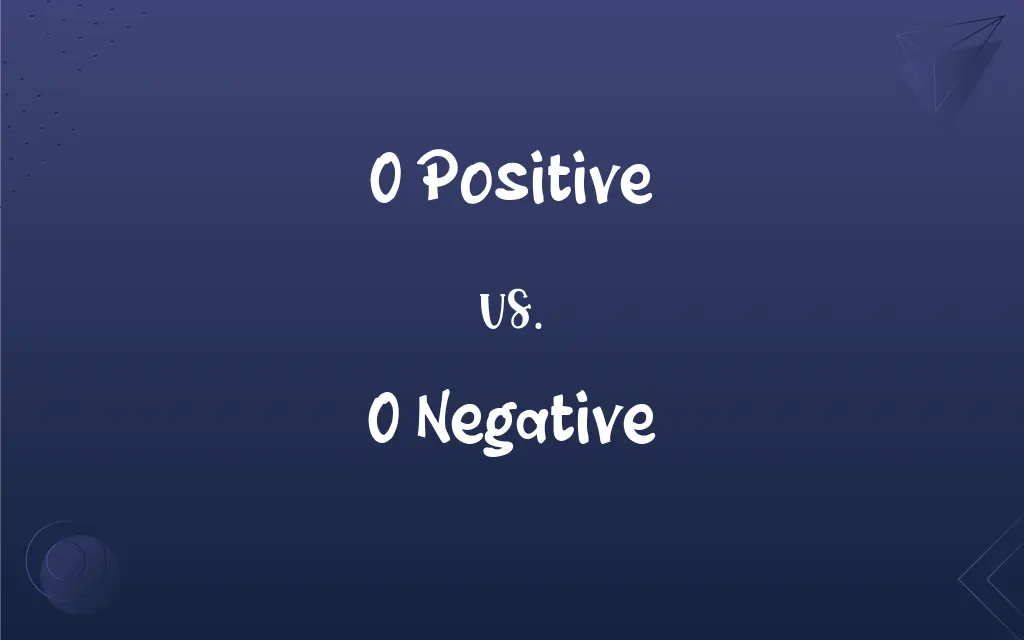O Positive vs. O Negative: What's the Difference?
Edited by Aimie Carlson || By Harlon Moss || Updated on October 3, 2023
O positive is a common blood type with Rh factor present, while O negative lacks the Rh factor and can be a universal donor.

Key Differences
O positive and O negative are both blood types under the ABO blood group system. O positive indicates the presence of the Rhesus (Rh) factor on the surface of red blood cells. In contrast, O negative does not have this Rh factor. These determinations are crucial in medical situations, especially during blood transfusions.
When considering O positive blood, it's the most common blood type globally. Recipients with O positive blood can receive transfusions from O positive and O negative donors. However, O negative is a bit more restrictive. It doesn't have the Rh factor, making it special in terms of donations.
O negative is often referred to as the "universal donor." This is because O negative blood can be given to recipients of any blood type, including O positive individuals. On the other hand, O positive blood can't serve as universally, being limited to those with the Rh factor in their blood.
Another significant difference between O positive and O negative is in pregnancy. If an O negative mother is carrying an O positive fetus, there can be complications. The mother's body may see the baby's O positive blood as foreign and produce antibodies against it. This doesn't happen with O positive mothers.
Comparison Chart
Rh Factor
Present
Absent
ADVERTISEMENT
Donation Recipient Range
Can donate to O positive and AB positive
Universal donor
Commonality
Most common blood type
Less common
Pregnancy Complications
No complications based on Rh
Potential complications with Rh positive fetus
Universal Recipient
Not a universal recipient
Can receive from any blood type
O Positive and O Negative Definitions
O Positive
A common blood classification indicating the absence of A and B antigens but the presence of Rh factor.
Most of the world's population is O positive.
ADVERTISEMENT
O Negative
O negative indicates a blood type within the ABO system lacking the Rh factor.
The hospital urgently needed O negative donors after the accident.
O Positive
The blood group that can donate to O and AB positive individuals.
She's O positive, so she can give blood to her AB positive brother.
O Negative
A designation in the ABO blood group system denoting the absence of A and B antibodies in plasma and absence of Rh.
Her medical card confirmed she was O negative.
O Positive
A designation in the ABO blood group system denoting the absence of A and B antibodies in plasma and presence of Rh.
Medical records showed he was O positive.
O Negative
The blood type without Rhesus factor, posing potential pregnancy complications with Rh positive fetuses.
O negative mothers may need medical intervention if their baby is Rh positive.
O Positive
O positive refers to a blood type within the ABO system with the Rh factor present.
My friend has an O positive blood type and donates blood regularly.
O Negative
Often called the "universal donor," able to donate blood to any ABO type.
Being O negative, he can donate to anyone in need.
O Positive
The most prevalent blood type which carries the Rhesus factor.
Due to its abundance, O positive blood is often in demand.
O Negative
A rare blood classification indicating the absence of A, B antigens and the Rh factor.
Only a small percentage of the population is O negative.
FAQs
What is O positive blood type?
O positive is a blood type with the Rh factor present.
Are there dietary recommendations specific to O positive or O negative?
While some diets suggest blood type-specific recommendations, there's limited scientific backing for these claims.
How can one determine if they're O positive or O negative?
Through a blood test at a medical facility or using a home testing kit.
Do O positive and O negative have distinct antigen structures?
Both lack A and B antigens, but O positive has the Rh factor, whereas O negative doesn't.
Can O positive and O negative blood be stored together?
While both can be stored, they are usually labeled and kept separately to ensure accurate transfusions.
Can O positive receive O negative blood?
Yes, O positive can receive O negative blood.
Can O negative receive O positive blood?
No, O negative individuals should only receive O negative blood.
Do O positive and O negative individuals have different health risks?
While there are some studies on blood type and health risks, individual health varies and shouldn't solely rely on blood type.
What is O negative blood type?
O negative is a blood type without the Rh factor.
Is O positive the most common blood type?
Yes, O positive is the most common blood type globally.
How rare is O negative?
O negative is rarer, making up a smaller percentage of the world's population.
Can O positive donate to anyone?
No, O positive can donate to O and AB positive recipients.
Are there pregnancy concerns for O negative women?
Yes, O negative mothers with O positive babies might face Rh incompatibility issues.
Can O positive mothers face the same pregnancy concerns?
No, O positive mothers don't face Rh factor issues with their babies.
Is it essential to know if you're O positive or O negative?
Yes, especially for medical interventions like blood transfusions or pregnancy.
Can an O negative person donate organs to O positive individuals?
Organ transplantation involves more factors than just blood type, but O negative can be a potential universal donor.
Which blood type is in high demand in blood banks?
Both O positive and O negative are in demand, especially O negative due to its universality.
Why might an O negative person be asked to donate more frequently?
Due to its universal donor status, O negative blood is often in higher demand.
Why is O negative called the universal donor?
O negative can be donated to any blood type, making it universally acceptable.
Is there a difference in the lifespan of O positive and O negative people?
No scientific evidence suggests a difference in lifespan based solely on these blood types.
About Author
Written by
Harlon MossHarlon is a seasoned quality moderator and accomplished content writer for Difference Wiki. An alumnus of the prestigious University of California, he earned his degree in Computer Science. Leveraging his academic background, Harlon brings a meticulous and informed perspective to his work, ensuring content accuracy and excellence.
Edited by
Aimie CarlsonAimie Carlson, holding a master's degree in English literature, is a fervent English language enthusiast. She lends her writing talents to Difference Wiki, a prominent website that specializes in comparisons, offering readers insightful analyses that both captivate and inform.































































